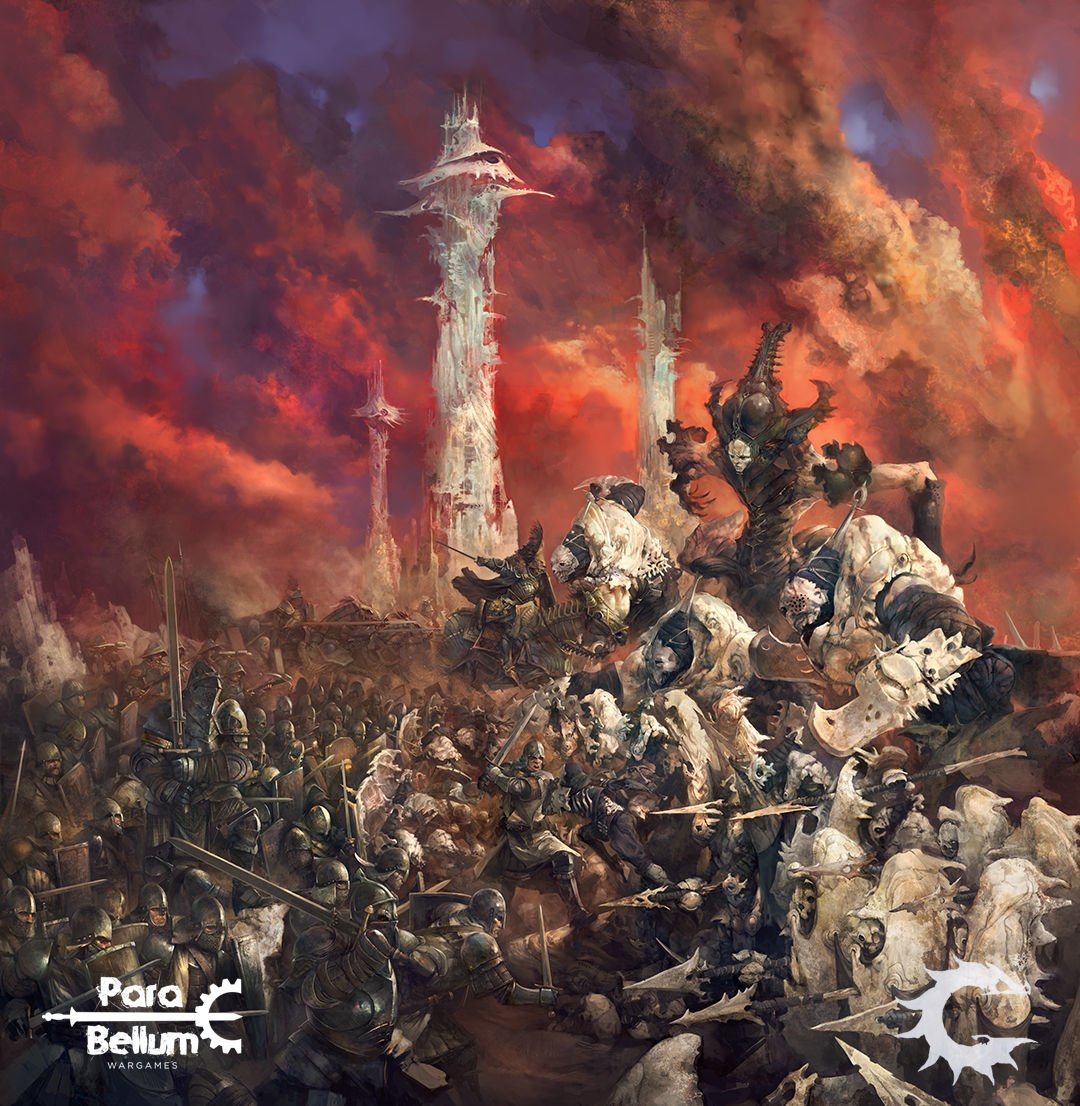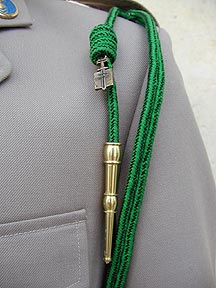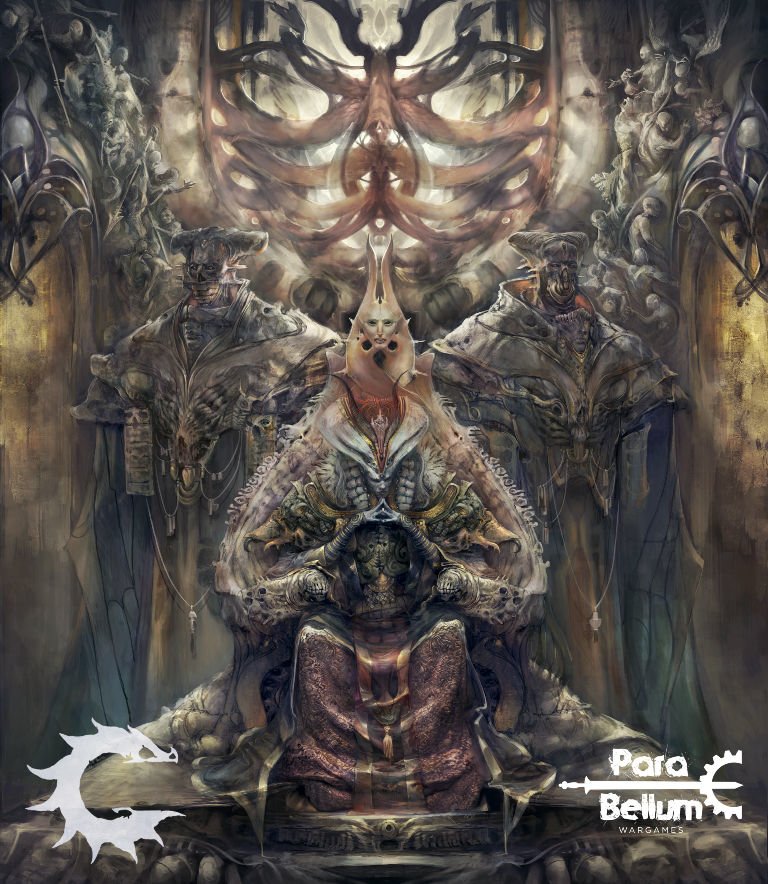This is me laying claim to and expanding upon an old comment over at Monsters and Manuals. That was on a Clauswitzian look at Warhammer 40,000 (hereafter 40k).
Anyway, here is the relevant text of the comment:
I have recently come to consider 40k as in some sense fuelling a 'Hobbesian' theory of tabletop wargames in a fictional setting: of a war of all against all.
To be more precise: every faction should have a reason in the background to fight every other faction AND to fight amongst themselves.
(To make it clear: the Imperium's internal struggles are perhaps only matched by their external ones, Chaos is self-explanatory on this point, as are the Orks, the Eldar probably don't want to kill one another on an ideological level but are so arrogant and splintered that they might well end up doing so, the Dark Eldar are backstabbers to a man, the Tau are very much unified - with one important exception that allows for the rule to stand, the Tyranids will feed on each other as much as on others and the Necrons have come out of stasis with all their old grudges intact.) [I believe this also stands for the former Warhammer Fantasy; Age of Sigmar perhaps not.]
Why should this be? Well, it allows for the maximum amount of in-person play, not needing any specific faction to have a game. Granted, it's going to look odd if one company of Ultramarines fight another company, but hardly unprecedented.
What we do we mean by Hobbesian? Well, Thomas Hobbes (of Malmsbury) was a 17th century English philosopher, best known for Leviathan - an account of political structures and social contract theory with an amazing cover.
Hobbes was notorious in his time* - more, I would suggest, for the methods used in his account of political society than his actual conclusions (see here for Ada Palmer's account of this). Of course, he wasn't a libertine or atheist like Rochester (at least, not of the kind of unbelief we would readily recognise). Hobbes doesn't end up by coming out in favour of direct democracy or a workers' cooperative; in as much as Leviathan may be called prescriptive rather than descriptive, it suggests something close to the absolutism of the 17th century, with some caveats.
The enduring image of Hobbes is in Part One of Leviathan, depicting a vision of mankind without government; this is then used to build up the parts of a Christian Commonwealth.
Whatsoever therefore is consequent to a time of war, where every man is enemy to every man, the same consequent to the time wherein men live without other security than what their own strength and their own invention shall furnish them withal. In such condition, there is no place for industry; because the fruit thereof is uncertain: and consequently no culture of the earth; no navigation, nor use of the commodities that may be imported by sea; no commodious building; no instruments of moving, and removing, such things as require much force; no knowledge of the face of the earth; no account of time; no arts; no letters; no society; and which is worst of all, continual fear, and danger of violent death; and the life of man, solitary, poor, nasty, brutish, and short.
Leviathan, Part One, Ch XIII, 9
It's a pessimistic view of the 'state of nature' (I believe this term is coined by John Locke. Hobbes refers to 'the natural condition of mankind'), but an enduring one. Hobbesian, therefore, refers to this imagined state of constant struggle, or a state of being much like it. This definition is, certainly, not as partial and derogatory as when we use Machiavellian to refer to sinister conspirators, but is still incomplete.
***
So, then, to the Tabletop. Let us consider three categories of war game settings.
First, war games set in real-world history, or something very like it. Players refight the Battle of Marathon, or the Corunna Campaign, or the Russo-Japanese War - or even something smaller and less formal, like the Gunfight at the OK Corral or the Siege of Sidney Street (stretching the definition of 'War', I know - but I imagine a war game should include the possibility of portraying insurgencies and non-state actors). We might include counterfactuals on this list as well - IE, a hypothetical Seige of Washington DC after a Confederate victory at Gettysburg.
Team Yankee, which deals with the Cold War breaking out into open conflict using conventional weapons, like Tom Clancy's novel Red Storm Rising, would count here. It is imagining a third world war fought with the expected weapons and alliances of the 1980s; even if the imagined conflict is driving military innovation, we don't see brand new models of tank on the battlefield, still less NATO laser artillery and Soviet airships.
At any rate, this first sort of war game is not really Hobbesian. The Austro-Hungarian Empire won't betray Germany at the drop of a hat in 1916; there are expected alignments and relationships.
Second, we may refer to war games set in pre-existing fictional settings. The Middle-Earth Strategy Battle Game (once The Lord of the Rings Strategy Battle Game known to my youth) sorts its factions into Good and Evil very neatly (a game based on The Silmarillion might do differently, given that history of rash oaths, treachery and kin-slaying, but the Strategy Battle Game as given is pretty firmly wedged in the Third Age of Middle-Earth). Star Wars miniature games seem to largely do likewise - it would be a strange Star Wars piece of media that portrayed the Rebel Alliance breaking down into sectarian violence.
Even if we are were to imagine a war game based on a property without Black Hats and White Hats, the notion that factions and characters stick to their canonical allegiances and motivations shines through. Even A Song of Ice and Fire (adapted for television as A Game of Thrones), in its war game (A Song of Ice and Fire Tabletop Miniatures Game) portrays House Tully and House Tyrell as integral parts of the forces of House Stark and Baratheon, respectively. This despite them both being great houses and nominal equals in their own right - and despite the oft-Hobbesian tone of the battles and intrigues of ASoIaF. In my survey of the above website, I think you could assemble an independent Tully/Mercenary force that adhered to the rules as given- but I don't know how competitive it would be.
Anyway, this second type of war game appears to be rarely Hobbesian. So you'll guess that the Third category (of three) will be the Hobbesian one. And you'd be right.
The Third category is, then, those war games set in an original setting designed for the sake of the game (or, potentially, for a universe conceived from the beginning to work in a variety of media). Again, 'Every faction should have a reason in the background to fight every other faction AND to fight amongst themselves.' I've laid out how 40k meets the conditions above**; Warhammer Fantasy as was meets them as well, more or less.
[Ahem: The Empire and Bretonnia are divided feudal polities very ready to do battle over honour or religion; Chaos Warriors, Daemons, and Beastmen are self explanatory, as are Orks and Goblins; the Skaven's internal competition is rabid; Ogre Kingdoms are like the Skaven but boisterous instead of manic; Dwarfs will go to war over five unpaid farthings; Vampire Counts are haughty, self-absorbed and competitive; the Tomb Kings have risen from the sands with all their pride and grudges intact; Dark Elves are malevolence personified, quite ready to betray one another; Wood Elves have a streak of fey wildness to them that would give rise to conflict - and at least one elf-hating Dryad; High Elves are comparatively harmonious and well-adjusted - but are collectively proud and arrogant, to say nothing of somewhat isolationist; Lizardmen may argue over the ruins of the Great Plan, and there are those beyond Lustria and the guidance of the Slann]
Well, so much for Warhammer, great overwhelming monolith that it is. What of other Third-category war games?
Consider Conquest: The Last Argument of Kings, by Para Bellum (an illustration for which is below).
 |
As found here.
I feel that this style of fantasy illustration - lush, painterly, deeply coloured, detailed without the glossy primped look that characterises some artwork - is something I've seen quite a bit of lately (think Karla Ortiz's cover to Sorcerer of the Wildeeps and some of the art for 28). I wish I had a good name for it. |
As a survey of the setting's lore suggests, they fit the Hobbesian mould pretty well. A shattered empire of A Hundred Kingdoms, the cruel biotech-wielding precursors of the Spires, savage and potent outland raiders, wrath-corrupted delvers - and each with it's own set of sub-factions, providing not only unit variety but also competing forces.
So much for Conquest. And you might say that this follows too close to Games Workshop to really count - compare Warhammer's Empire with the Hundred Kingdoms, or 40k's (Dark) Eldar with the Spires. Let's pick out a few more examples.
A Very British Civil War is an alternate history - a counterfactual in the same vein as Team Yankee above. There are some relatively outlandish or eccentric forces, but nobody appears to have taken up a form of technology beyond the 1930s. The background is that the Abdication Crisis of 1936 has resulted in constitutional turmoil and finally civil war. Fascists, Socialists, Edward VIII-loyalists, Anglicans, Scotch nationalists and more compete for rule of Great Britain (games in the Empire are possible, but out of focus; foreign intervention is present in the form of volunteers and aid rather than armies).
Now, obviously, this differs from a fantasy setting, or the far-off 41st millennium. There's also a difference in tone - consider the illustrations, miniatures made or suggested for the game and the presentation and discussion of VBCW. Grimdark it ain't. If there is a single inspiration for it, it would be the 1995 film adaptation of Richard III*** set in an alternate 1930s - a part of the mannered, artificial (in the sense of 'crafted') text of Shakespeare's history plays carries over. Of course, the tone could be skewed more towards the realities of the (comparable) Spanish Civil War. But the default has the relative lightness suggested above.
Grimdark or not, it fits: every faction should have a reason in the background to fight every other faction AND to fight amongst themselves. It is a time of civil war - brother is already fighting brother (literally, given Edward and Albert....) - so further shifting allegiances are to be expected. Further, given how isolated and cut off some of these forces may be, it should not surprise us that one Royalist regiment might find itself attacking another.
One more. Infinity by Corvus Belli lays out a science fiction setting; colonised star systems, new frontiers, exciting and powerful technologies. The inspiration of Infinity lies in an inter-connected, Information Age world, full of smooth, colourful stylings and with a primarily Asian derived group of interstellar factions (it even has its own manga). The battles depicted are 'secret missions, black ops and covert actions' rather than grinding trench warfare or frenetic melee combat. It is distinct, therefore, from the decay, zealotry, Gothic architecture and gloom of 40k .... despite the power-armoured religious military orders.
None of this makes Infinity a pleasant future to consider, per se. There is an extra-terrestrial threat, rebellion and the sleek outlines of postcyberpunk futures may well conceal pain and suffering. But again it fits the Hobbesian requirements for a world of wetwork and realpolitik. Sub-factions ('sectorials') once again abound - as to be expected in interplanetary polities. Left hand may not know what the right hand is doing (or know and dislike it intensely, or think it knows, or feels it needs to find out just in case....)
***
Assuming, therefore, that you are with me as far as this division of war games and my conclusions about their Hobbesian nature goes, why does this matter? I would suggest that this is a rule that appears obvious once you know it, informing the structure of war games without it being explicit and that it is a useful tool if one is debating the aesthetics and lore (and their implications) of war games in that third category. There will be a tendency to the Grimdark, at the very least.
Compare this to the origins of the Horus Heresy. Now a novel series of over fifty books, some of them bestsellers (as well as audio dramas, miniatures, artwork, reams of online discussion &c) - and it all came about because of the cost of making new moulds for miniatures****. The Hobbesian theory lurks in the foundations of war gaming in just the same manner.
Is any of the above consciously noted by war game designers? I wouldn't like to say. Does it matter? Once a given war game is popular enough that plenty of people play it and the number of factions and sub-factions swell, the need for a Hobbesian world abates. (You might be able to say this for Games Workshop's Age of Sigmar. I'm not sure I care to do so here - I don't know enough.) Besides, this only really counts for impromptu games. Tournaments will presumably try to organise things that the Armageddon Steel Legion player won't have to fight other Armageddon Steel Legion (or other Guard regiments, or the forces of the Imperium). This goes doubly so for grand international event campaigns - which works for in-universe explanations; even the most hot-headed or scheming of Imperial commanders know this really isn't the time.
Yet, a note of the Hobbesian persists - in lore, in rules, in structures. Like evolutionary advantages that make more sense for the Savannah, but still persist despite life in (say) 1986 Vancouver. I assert that an understanding of a war game of the Third category and the materials that develop from it is improved by at least considering the Hobbesian theory.
*And I imagine that any present-day politician that cited Hobbes as an influence or inspiration would catch a fair amount of flak for their trouble.
**I left out sub-factions &c, but even tightly-knit compact factions like the Adeptus Custodes have institutions like the Blood Games. Exodites are sufficiently clannish to clash with one another; Harlequins would do it for the art. Genestealer Cults, as criminal/insurrectionary organisations would certainly jostle with one another - and, quite possibly, their Tyranid puppeteers.
***Suffering catfish, that trailer - no wonder they changed it for the rerelease!
****(VW Talos, 'Crafting the Imperium's Greatest Heel-Face Turn', 28, Vol. 2, February 2020 pp 96-103)





